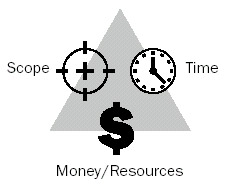Chapter 9: Checking and Adjusting the Project Plan
Overview
In a perfect world, you'd define the project scope, schedule tasks , assign resources, and presto! The project plan would be finished and ready to execute.
In reality, however, this is rarely the case. After you've scheduled tasks and assigned resources, you generally need to check the results and see whether they meet expectations and requirements. Ultimately, you might need to answer one or all of the following questions to your satisfaction and to the satisfaction of your managing stakeholders:
-
Will the project be finished on time?
-
Is the project keeping to its budget?
-
Do the resources have the appropriate amount of work?
If you get the wrong answers to any of these questions, you need to adjust your project plan until you get the right answers. For example, if the finish date is too far away, you can add more resources to major tasks.
After you make such adjustments, you need to check the project plan again. Adding resources to tasks might bring in the finish date, but it also might add cost if you hired additional resources or authorized overtime. And if you assigned more tasks to existing resources, those resources might be overallocated.
To save time as well as money, you might decide to cut certain tasks, a deliverable , or a phase. But if this means you're cutting project scope, you probably need to get approval from your managing stakeholders.
This relationship between time, money, and scope is sometimes referred to as the project triangle (see Figure 9-1). When you change one side of the triangle, it affects at least one of the other sides of the triangle.

Figure 9-1: Managing your project requires balancing time, money, and scope.
You need to know which side of the triangle is your most important consideration. Is it schedule ”you definitely have to finish by November 14? Is it budget ”there is absolutely $264,300 for this project, and not a penny more? Is it scope ”it is imperative that each and every task in your project plan be implemented? Only one side of the triangle can be "absolute." The other two sides must be flexible so you can adjust the project plan to hit that one absolute.
Depending on which side of your project triangle is your absolute, you might adjust your project plan to do one of the following:
-
Bring in the project finish date
-
Reduce project costs
-
Cut project scope
Although not strictly a part of your project triangle, it's likely that you also will check resource workloads. Resources are the biggest part of your project costs. If any resources are overallocated, you might be facing more overtime than your budget will allow. If resources are grossly overallocated, you run the risk that the tasks won't be done on time and the entire project will slip. If any resources are underallocated, you might be paying more for resources than you should, which also affects your budget.
After you make your adjustments and balance your project triangle to meet the project requirements, you'll be ready for stakeholder buyoff. After you have buyoff , you'll be ready to start the execution phase of the project.
| |
Your project scope, finish date, and budget can be imposed on you for various reasons, depending on the type of project and the specific situation. The following are a few examples:
-
You are a seller or potential subcontractor bidding on a project whose scope has been defined in the Request for Proposal (RFP). You need to provide the full scope, but your costs and finish date must be competitive with other bidders. If possible, you'll want to include value-added items to give your proposal an advantage while still making a good profit.
-
You are a subcontractor and you have been awarded the contract based on a proposal including broad assumptions of scope, finish date, and cost. Having taken this risk, now you must create a detailed project plan that will actually implement that finish date, cost, and scope.
-
You've been assigned as project manager of a project within your company. The scope, budget, or finish date have been handed down as one or more of the project assumptions. Your success is predicated upon your ability to implement the project within those limitations.
-
You've been assigned as project manager of a project within your company. You and other stakeholders developed the scope to a fair level of detail. It's up to you to propose the budget and finish date for the project.
-
You are the project manager and you've balanced your project triangle the way you believe is best. However, after you submitted the project plan for client review, certain new project requirements or limitations surfaced. You have to readjust the project triangle to take the new limitations or requirements into account.
| |
EAN: 2147483647
Pages: 268